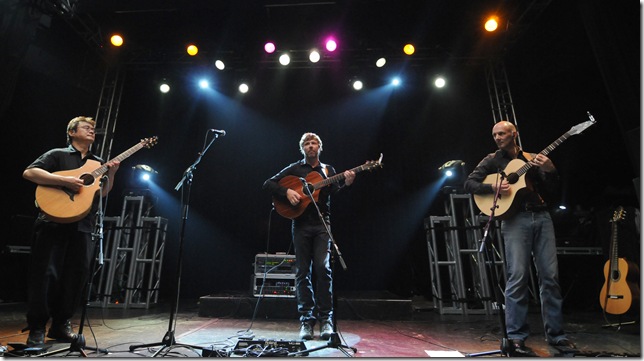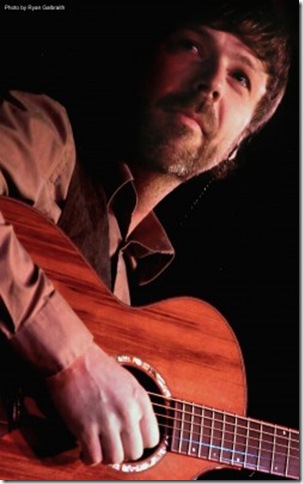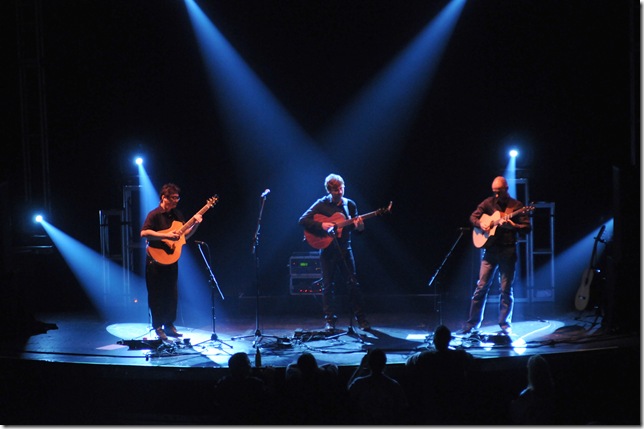For a group that named itself for the state where it formed — doubting that it might ever get to play elsewhere — the California Guitar Trio (www.cgtrio.com) has achieved stratospheric success.
The CGT’s three acoustic guitarists, Paul Richards, Bert Lams and Hideyo Moriya, have recorded a dozen CDs together and navigated several tours of the United States, Canada, South America, Europe and Japan. This Saturday, they’ll play the Lifelong Learning Society Auditorium on the Florida Atlantic University campus in Jupiter.
The group’s latest release, Andromeda (Innerknot), celebrates their forthcoming 20-year anniversary, but this is certainly not a trio that’s achieved longevity through doing what might be expected.
Andromeda is their latest blend of composition and improvisation, and it mixes everything from classical, surf and world music to rock, jazz and blues. The all-original disc also combines seemingly disparate musical mindsets, as the trio achieves its self-described “super piano” sound through its layered acoustic guitars — yet with the wooden instruments sometimes running through processors to mimic a variety of other tones, from electric guitars to synthesizers.
“We recorded the basic tracks using vintage analog tape gear at Funeral Home Studios in Louisville, Kentucky,” Richards says. “Then we blended in the digital Roland and Moog effects to layer things. We’ve always been interested in exploring different sounds and textures through electronics, and this album is probably our most extreme example of that. On one track, ‘Improv VIII (Layered Circulation),’ we each played a note at a time in sequence to create a melody, or circulation. Then we used an old Les Paul trick, turning the tape machine to half-speed and recording over the top of that. So when you play it back, we’re an octave higher.”
The three guitarists have some classical training, but they primarily play steel-stringed rather than common nylon-stringed classical guitars. And their world travel is befitting of diverse, United Nations-approved backgrounds, since Richards is from Salt Lake City, Utah; Lams from Affligem, Belgium; and Moriya from Chiba, Japan. They met at an instructional course taught by a British guitarist who’s known more for leading the iconic 42-year-old progressive rock band King Crimson.
“Robert Fripp was initially offering a series of week-long introductory Guitar Craft courses in the mid-1980s,” says Richards. “I was studying jazz at the University of Utah at the time, but my teacher had attended one of Robert’s courses, and he suggested that I do the same. I did, and it changed my life. The first one I attended was held near Washington, D.C., but then Robert bought a house in the English countryside and invited students to live and study there for extended periods of time. I was there for almost two years, and that was when I met Bert and Hideyo.”
Fripp is known for his unorthodoxy as both a guitarist (his circular, interlocking patterns owe more to classical and Eastern music than to blues) and bandleader (he’s purposely scrapped, re-shuffled personnel and re-started King Crimson several times since the band’s 1969 inception). As a teacher, his outside-the-box thinking may have appealed to the three guitarists even more than his music.
“He actually didn’t like us to use the word teacher,” says Lams. “Robert saw himself as an instructor, and thought there was a great difference between those two terms. He was there to share his experiences with us, since he’d already been a professional musician for 30 years. It was nothing like a standard school would present, because he even welcomed people with little to no guitar experience. To have someone of that stature be so giving was a great privilege, and it provided us with huge short-cuts.”
Richards called Fripp “an amazing instructor.”
“I was in a great jazz program at the University of Utah, but I felt much more at home in the Guitar Craft series,” he says. “Robert’s way of instruction spoke to me more directly, and it was more spiritual, but not in a New Age way. It was all very practical, and directed toward making you a better guitarist, musician and person.”
One of Fripp’s practical methods particularly caught the students off-guard.
“We all ended up playing in Robert’s League of Crafty Guitarists ensemble,” Richards says. “But he’d only told us previously that we were going to have a two-month-long course on performing. When we showed up for the first class, we found out that he’d booked a tour! His way of teaching us how to perform was going out and playing concerts.”
Those performances between 1988 and 1991 fueled the formation of the CGT, since Fripp was in the early stages of restarting the dormant King Crimson again.
“Robert asked Bert who he wanted to work with,” Richards says, “because I think he had a sense at that time that he would be moving on to other projects. Bert had just moved to Los Angeles, and he asked myself and Hideyo if we wanted to start a group there, so that’s where the California Guitar Trio got started.”
The trio went from performing in West Coast clubs in 1991 to a tour of Japan and Italy in 1992 with Fripp, singer/songwriter David Sylvian and another of Fripp’s students, Trey Gunn (who plays a customized guitar/bass hybrid called a Warr guitar, which he’d soon employ in a new King Crimson lineup).
The first CGT album, Yamanshi Blues, didn’t appear until 1993, but the guitarists toured with Fripp yet again in 1995 in support of their sophomore effort, Invitation. They opened shows for King Crimson’s “double trio” lineup — a wall of sound featuring guitarists Fripp and Adrian Belew, Warr guitarist Gunn and bassist Tony Levin (who doubled on Chapman stick) and drummer/percussionists Bill Bruford and Pat Mastelotto. The sextet had just released THRAK, the first full-length King Crimson studio CD in more than a decade.
The CGT’s first-ever show in Florida, in fact, was opening for King Crimson on Nov. 7, 1995, at the since-demolished Sunrise Musical Theatre.
“We ended up doing 130 shows with King Crimson in 1995 and 1996,” Lams says. “It was a great experience, and we still have people coming up to us after shows and saying, ‘I saw you guys for the first time when you opened for King Crimson.’ Fifteen years later, we’re still riding that wave.”
The bulk of the trio’s classical wave resides with Lams, who plays a nylon-stringed guitar on one track, Hazardous Z, on Andromeda.
“Growing up in Brussels, I figured the best way to become a professional guitarist was to study classical guitar,” he says. “I was able to study with Monique Vigneron, who’d been a student of Andres Segovia, and she helped me improve enough to attend the Royal Conservatory there. After that, I became a classical guitar teacher for about 10 years.”
The early CGT albums featured several Bach and Beethoven compositions, but Lams wasn’t drawn toward Fripp through the classically influenced King Crimson as much as one of its leader’s side projects. Fripp’s League of Gentlemen band released only one self-titled album in 1981, but its sound was decidedly more in the pop and New Wave realms.
“I wasn’t particularly a big fan of progressive rock,” Lams says, “but I decided to see Robert and the League of Gentlemen in Belgium, and I was blown away by his playing. His guitar lines were much cleaner than with King Crimson, so I even went to see them nearby on the next night. I was playing classical guitar at the time, but always on the lookout for something new and fresh. So when I saw the ad for Robert’s Guitar Craft course after seeing him live, it was a no-brainer.”
Richards was the most rock-influenced of the three guitarists in his teens, which led to cover recordings such as Heart of the Sunrise by Yes and Discipline by King Crimson as the trio forged into the 21st century. And Mastelotto, and particularly Levin, have been recurring guests on CGT CDs. The bassist appears on the Andromeda track Turn of the Tide to tap out one of his inimitable Chapman stick lines.
Andromeda is the first all-original CGT release, but it follows the all-cover 2008 CD Echoes, which features two more classical-inspired pieces (Unmei and Pastorale) plus the Pink Floyd title track, Mike Oldfield’s Tubular Bells, Queen’s Bohemian Rhapsody and even Lynyrd Skynyrd’s Free Bird. The group is working on an all-classical CD for 2011 release.
“It’ll be mostly previously recorded but unreleased tracks,” Lams says, “but all remixed and remastered from the original takes. We’re trying to make it sound pure, like you’re sitting in a room with the guitarists. One track is a cover of the ‘William Tell Overture’ that turned out pretty hot.”
Richards still resides in Salt Lake City, and Lams has relocated to Mechanicsburg, Pa., but this small, united league of ever-crafty guitarists remains international.
“Hideyo initially left the Berklee College of Music in Boston to study in the Guitar Craft courses,” Richards says. “But he decided to live in Japan and commute after we formed the trio. Even when we were initially based in Los Angeles, he’d come there for two or three months at a time and then go back. I can tell that he gets homesick when he’s away from Japan for too long.”
The CGT has, in fact, literally gone beyond international to stratospheric success. Other artists may have also been heard on NPR, NBC, CBS, CNN and ESPN — but this trio received recent airplay aboard the NASA space shuttle Endeavour.
“We have some fans in Houston, Texas who work for NASA,” says Richards. “They invited some of the astronauts to come out and hear us, so we developed a pretty strong fan base at NASA, and they started using our music to wake up the astronauts. It was pretty unusual to hear that, and very exciting.”
“There’s a clip they’ve sent us,” Lams says, “where you hear not only our recording playing aboard ‘Endeavour,’ but what the astronauts say before and after hearing it, even down to things like ‘Houston, over and out.’”
The trio’s actual 20-year anniversary takes place within 10 days of its stop at the FAU campus in Jupiter. And the three space-approved guitarists are united in the surprise regarding their longevity.
“It was 20 years ago in January that we formed,” Richards says. “We’d become friends while touring with Robert, but there was also clearly a musical connection despite our very different backgrounds. Hideyo grew up learning to play surf music instrumentals by The Ventures, who are still huge in Japan. Bert had the European classical upbringing, and I had two older brothers who played guitar, so I was listening to The Beatles, Rolling Stones, Led Zeppelin and Rush. But I think we’re stronger because we’ve been able to find ways to combine all of our different upbringings and influences.”
Lams notes that their first-ever performance was on Feb. 7, 1991, at the Natural Fudge Café in Los Angeles.
“And we couldn’t have had any idea that it would turn into this.”
The California Guitar Trio performs at 7:30 p.m. Saturday at Florida Atlantic University’s Lifelong Learning Society Auditorium, 5353 Parkside Drive, Jupiter . Tickets: $25 for Lifelong Learning members; $30 for non-members. Call 561-799-8547.


